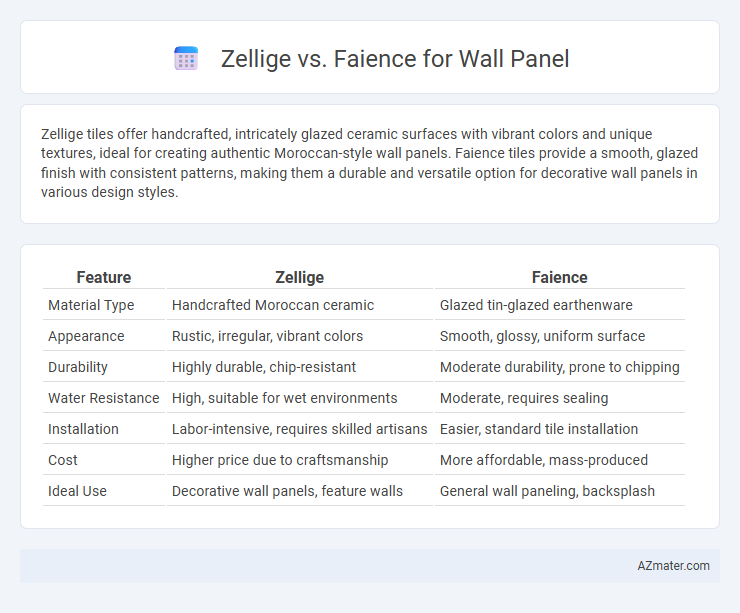Zellige tiles offer handcrafted, intricately glazed ceramic surfaces with vibrant colors and unique textures, ideal for creating authentic Moroccan-style wall panels. Faience tiles provide a smooth, glazed finish with consistent patterns, making them a durable and versatile option for decorative wall panels in various design styles.
Table of Comparison
| Feature | Zellige | Faience |
|---|---|---|
| Material Type | Handcrafted Moroccan ceramic | Glazed tin-glazed earthenware |
| Appearance | Rustic, irregular, vibrant colors | Smooth, glossy, uniform surface |
| Durability | Highly durable, chip-resistant | Moderate durability, prone to chipping |
| Water Resistance | High, suitable for wet environments | Moderate, requires sealing |
| Installation | Labor-intensive, requires skilled artisans | Easier, standard tile installation |
| Cost | Higher price due to craftsmanship | More affordable, mass-produced |
| Ideal Use | Decorative wall panels, feature walls | General wall paneling, backsplash |
Introduction to Zellige and Faience
Zellige and faience are traditional ceramic tiles widely used for decorative wall panels, with zellige originating from Moroccan craftsmanship known for its hand-cut, glazed terracotta pieces forming intricate geometric patterns. Faience, on the other hand, refers to tin-glazed earthenware originating from Mediterranean regions, characterized by its smooth, glossy surface and often painted motifs. Both materials offer distinct aesthetic qualities, with zellige emphasizing textured surfaces and vibrant colors, while faience provides a more uniform, polished finish suitable for elegant wall panel designs.
Historical Origins and Cultural Significance
Zellige, originating from Moroccan artisan traditions dating back to the 10th century, is renowned for its intricate hand-cut geometric patterns and glazed terracotta tiles that reflect Islamic art's influence. Faience, with roots in ancient Egypt and later flourishing in Renaissance Europe, features tin-glazed earthenware known for its vibrant colors and glossy finish, often depicting floral and figurative motifs. Both serve as culturally significant wall panels, with Zellige emphasizing geometric abstraction and spiritual symbolism, while Faience showcases storytelling through pictorial designs and historical narratives.
Material Composition and Manufacturing Techniques
Zellige tiles are handcrafted Moroccan ceramics made from natural clay, shaped into geometric pieces, and glazed with vibrant, traditional colors using a labor-intensive process involving polishing to achieve a distinctive glossy finish. Faience, on the other hand, is a tin-glazed earthenware originating from Europe, featuring a delicate, opaque white glaze on a finer clay body, typically produced through mold-casting or slip-casting methods that allow for intricate designs and smoother surfaces. The material composition of Zellige emphasizes natural, coarse clay and vibrant metal oxide pigments, whereas Faience relies on a white opaque glaze to create detailed decorative motifs, reflecting divergent manufacturing philosophies and aesthetic outcomes.
Visual Differences: Color, Texture, and Pattern
Zellige tiles showcase rich, vibrant colors with a hand-glazed finish that creates subtle variations in hue, giving each piece a unique, artisanal texture and irregular surface. Faience tiles typically feature smoother, more uniform surfaces with a glossy finish and often display intricate, repetitive patterns that emphasize symmetry and precision. The visual impact of Zellige lies in its organic, rustic aesthetic, while Faience offers a polished, refined look with detailed, consistent designs.
Durability and Maintenance
Zellige tiles, made from natural clay and fired at high temperatures, offer exceptional durability and resistance to wear, making them ideal for long-lasting wall panels. Faience, a glazed ceramic material, provides a smooth, glossy finish but is generally less robust and more prone to chipping or cracking under impact. Maintenance of zellige involves gentle cleaning to preserve its textured surface, while faience requires careful handling to avoid damaging the delicate glaze during cleaning.
Suitability for Interior and Exterior Walls
Zellige tiles, handcrafted from natural clay and glazed with vibrant colors, offer exceptional durability and water resistance, making them highly suitable for both interior and exterior wall panels, especially in humid or wet environments. Faience tiles, known for their smooth surface and detailed patterns, perform best on interior walls due to their lower resistance to weathering and moisture exposure. Choosing Zellige for exterior applications ensures long-lasting beauty and resilience, while Faience excels in decorative indoor settings where intricate designs are prioritized.
Cost Comparison and Value
Zellige tiles, handcrafted from natural clay, tend to be more expensive than faience due to their artisanal production and unique glazing process, often costing 50-100% more per square foot. Faience tiles, mass-produced and glazed ceramic, offer a budget-friendly alternative with consistent quality and lower installation costs. Despite higher upfront expenses, Zellige panels provide greater long-term value through durability, unique aesthetic appeal, and potential for increased property value.
Installation Challenges and Considerations
Zellige tiles, handcrafted from natural clay, require meticulous installation due to their irregular shapes and varying thickness, demanding skilled artisans to achieve a seamless wall panel. Faience tiles, typically uniform in size and shape, offer easier installation but require careful grout selection to prevent cracking in high-moisture areas. Consider surface preparation, adhesive compatibility, and maintenance needs when choosing between Zellige's artisanal texture and Faience's glazed finish for durable, aesthetic wall panels.
Design Flexibility and Customization Options
Zellige tiles offer exceptional design flexibility thanks to their handcrafted, irregular shapes and rich color variations, enabling unique, artistic wall panel compositions that reflect Moroccan heritage. Faience tiles provide a broader range of consistent patterns and glazes, allowing for precise, repeatable designs that suit modern and traditional aesthetics. Customization options in Zellige emphasize artisanal finishes and organic textures, while Faience excels in detailed motifs and glossy surfaces that can be tailored to specific design schemes.
Choosing Between Zellige and Faience: Key Takeaways
Zellige tiles, crafted from natural clay and characterized by their hand-cut, irregular shapes, offer a unique, artisanal aesthetic suitable for creating textured, vibrant wall panels with a rich Moroccan heritage. Faience tiles, made from tin-glazed ceramic, provide a glossy, uniform surface ideal for sleek, classic wall designs requiring durability and easy maintenance. When choosing between Zellige and Faience for wall panels, consider factors such as desired texture, visual appeal, ease of installation, and maintenance needs to align with your interior design goals.

Infographic: Zellige vs Faience for Wall panel
 azmater.com
azmater.com